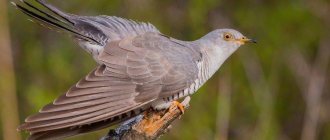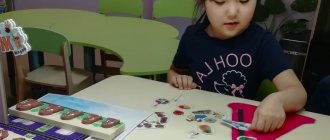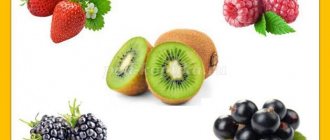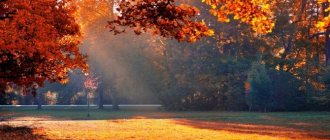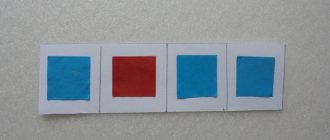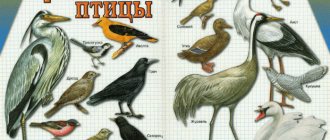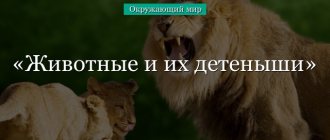LiveInternetLiveInternet
Quote from Tatyana57
Read in full In your quotation book or community!
SPEECH DEVELOPMENT. LEXICAL TOPIC “MIGRATION BIRDS”.
CHILDREN SHOULD KNOW THE NOUNS: rook, starling, swallow, swift, cuckoo, crane, geese, swans, lark, thrush, nest, birdhouse, male, female, chicks, eggs, singer, insects, larvae, plumage, flock, countries, legs , neck, wing, eyes, tail, beak, head, stork, heron. VERBS: fly, fly away, arrive, return, build, clean, set aside, curl, hatch, hatch, feed, grow up, get stronger, squeak, sing, curl, leave, say goodbye, gather, eat, peck, destroy, curl, nip, glue, blind. ADJECTIVES: big, small, singing, black, warm (edges), white, striped, caring, busy, spring, strangers, fluffy, ringing, field, distant, beautiful, long-legged, waterfowl, agile, vociferous. LET'S TELL ABOUT BIRDS. Migratory birds are birds that fly from us in the fall to warmer regions. These birds are insectivores (eat insects) and feed on insects.
In the fall, insects hide, the birds have nothing to eat, so they fly away. Ducks, geese and swans fly away in a line - a string.
Swallows and starlings fly away in a flock.
Cranes fly away in a wedge - an angle.
And the cuckoos fly away one by one. In spring, migratory birds return to us. Birds have a head with a beak, a body with two wings, two legs with claws, a tail and plumage.
CHILDREN SHOULD BE ABLE TO IDENTIFY EXCESS AND EXPLAIN: WHY? Magpie, crow, tit, swallow (swallow is a migratory bird, the rest are wintering). Lark, sparrow, rook, starling. Crow, duck, dove, sparrow. Rook, tit, swallow, cuckoo. Magpie, sparrow, woodpecker, swift. Dove, swan, heron, crane. Beetle, butterfly, chick, mosquito (chick is a bird, other insects). CORRECTLY NAME CHICKENS: Cranes are crane babies. Rooks - rooks. Geese are goslings. Starlings are starlings. Ducks -…. Cuckoos - ... . Swifts - ... . CORRECTLY ANSWER THE QUESTIONS: WHOSE? WHOSE? WHOSE? WHOSE? Whose beak? The crane has a crane-like appearance. The goose has goose. The duck has…. The cuckoo has…. The rook has…. ONE IS MANY. Cuckoo - cuckoos. Crane - cranes. Starling - starlings. Nightingale - nightingales. Lark - larks. Swan - swans. Rook - rooks. Duck - ducks. Swallow - swallows. Rook - rooks. Stork - storks. Gosling - goslings. WHO VOICES: The cuckoo cuckoos. The swallow is chirping. The starling sings. The crane is cooing. The duck quacks. The goose cackles. DESCRIBE AND COMPARE BIRDS ACCORDING TO PLAN: Wintering or migratory bird? Why are they called that? Appearance (tail, head, wings, body, beak, feathers, colors...) What does it eat? Where it lives - a hollow, a birdhouse, a nest... COMPILATION OF A DESCRIPTIVE STORY. The rook is a black bird with a white beak. The rook has a head, body, wings, tail, and paws. The bird's entire body is covered with feathers. In the spring, rooks fly from warm countries, build nests and hatch chicks - rooks. Rooks feed on insects, worms and plant seeds. In the fall, when it gets cold, rooks gather in flocks and fly away to warm countries until spring. Rooks help humans; they destroy insects and caterpillars - pests of fields and vegetable gardens.
The grass is turning green, the sun is shining, the Swallow is flying towards us in the canopy in the spring. With her, the sun is more beautiful and spring is sweeter... Say hello to us from the road as soon as possible. I’ll give you grains, and you sing a song that you brought with you from distant lands. (A. Pleshcheev) GIVE A WORD. There is a palace on the pole, in the palace there is a singer, and his name is ... (starling). CALL IT TENDINGLY: Nightingale - nightingale. Crane - crane. Swan - swan... WHO has WHO? The cuckoo has a cuckoo, cuckoo. The crane has a baby crane, crane babies. The starling has a little birdling, starlings. The swan has a baby, swans. The rook has a rook, rooks. The duck has a duckling, ducklings. The stork has a baby stork, baby storks. The goose has a gosling, goslings. END THE SENTENCE WITH THE WORDS “LONG-LEGGED CRANE”: In the field I saw ... (long-legged crane). I watched for a long time... (long-legged crane). I really liked this beautiful and slender... (long-legged crane). I wanted to approach... (long-legged crane). But he got scared and flew away. He flew beautifully, spreading his wings and circling in the sky... (long-legged crane). I told my mother about... (long-legged crane). Mom said that you shouldn’t come up and scare... (the long-legged crane). I promised my mother not to approach... (the long-legged crane) anymore. Now I will only watch from afar... (long-legged crane). CHOOSE THE PREPOSITION RIGHT BY MEANING (FROM, IN, TO, OVER, ON, ON): The rook flew out... nest. The rook has arrived... nest. The rook flew up... to the nest. The rook is circling... with his nest. The rook sat down... on a branch. The rook walks ... arable land. WE IMPROVE THE ABILITY TO RELL. RETELL THE STORY ACCORDING TO THE QUESTIONS: The rooks have arrived. The rooks arrive first. There is still snow all around, but they are already here. The rooks will rest and begin to build nests. Rooks build nests on the top of a tall tree. Rooks hatch their chicks earlier than other birds. Which birds arrive first in spring? What do the rooks immediately begin to do? Where do they build their nests? When do they hatch their chicks? Harbingers of spring. The cold winter has passed. Spring is coming. The sun is rising higher. It heats up more. The rooks have arrived. The children saw them and shouted: “The rooks have arrived! The Rooks Have Arrived!" What was the winter like? What comes after winter? How does the sun warm in spring? Who has arrived? Who did the children see? What did they shout? RETELL THE STORY IN THE FIRST PERSON: Sasha decided to make a birdhouse. He took boards, a saw, and sawed the planks. From them he put together a birdhouse. The birdhouse was hung on a tree. May the starlings have a good home. COMPLETE THE SENTENCE: There is a nest on the tree, and on the trees... (nests). There are branches on the branch, and on the branches... . There is a chick in the nest, and in the nests - .... There is a tree in the yard, and in the forest - .... GUESS THE RIDDLES: Without hands, without an axe. A hut has been built. (Nest.) Appeared in a yellow fur coat, Goodbye, two shells. (Chick.) There is a palace on a pole, There is a singer in the yard, And his name is... (Starling.) White-billed, black-eyed, He walks importantly behind the plow, Finds worms and beetles. A faithful watchman, a friend of the fields. The first harbinger of warm days. (Rook.) READ THE POEMS ABOUT BIRDS, LEARN ONE OF THEM BY MONEY. Starlings. We even got up at night and looked out of the window into the garden: Well, when, well, when will our guests arrive? And today we looked - a starling was sitting on an alder tree. They arrived, they arrived, they finally arrived!
Lexical topic “Migratory birds” relationship with the teacher
Finger gymnastics
| Migratory birds The birds in the sky are melting, melting Birds fly away to the south. Everyone melted away Stork, herons, cranes | We wave our hands Palm with visor facing forehead Bend the little finger, ring and middle fingers in turn |
Breathing exercises
"Feather"
(we blow on the feathers while exhaling and say: “Pf-pf...)
"Stork"
Let's imagine that we have turned into a stork, walking with an important air through the swamp. The head is raised proudly, the back is straight. The wing arms are extended to the sides. As you inhale, raise your “wings” and one leg, bending it at the knee. Then we straighten the knee and stretch the toe forward. As you exhale, slowly lower your arms and legs, taking a step and saying “sh-sh-sh...”. Same with the other leg. It is recommended to repeat alternating inhalation and exhalation 6-7 times.
"Geese are flying"
Slowly walking around the room. As you inhale, raise your arms to the sides; as you exhale, lower it, saying a long: “G-u-u-u.” Duration 60 seconds.
Development of articulatory motor skills.
"Beaks of different birds."
Slowly suck your cheeks into the gap between your teeth. Lips are tightly closed and extended forward
"Hungry Chicks"
Open your mouth as wide as possible (the tongue lies at the bottom of the mouth, the tip rests against the lower teeth) and pronounce the syllables: “Am-am-am-am-am.”
Exercises for cheeks and lips.
“The mother bird drives the marten away from the chicks.”
Suck the upper lip under the lower one, and then sharply throw it out with your mouth open (smacking).
Tongue exercises
-
“The chicks are waiting for food.”
Make a “cup” out of your tongue and hold it for a count of six.
“Very tasty food!”
Suck your “wide” tongue to the palate, then pronounce the sound a-a-a.
"Stork".
Pull the “sharp” tongue out of your mouth as far as possible and hold it for a count of “six to eight.”
Development of facial muscles.
In autumn you said goodbye to the birds, ( Sad
).
Depict hungry birds on a frosty day. Convey your emotional state, you sympathize with the birds, feel sorry for them. Sad, pitiful face
).
The starling fell into the paws of the cat. ( Fear
) The birds returned from warm countries.
( Joy)
Lexical topic: “Birds of passage”
A story about birds
of birds in nature . Wherever you walk - in a city park, along the seashore, in a village, in a forest - you will meet birds . Almost all of them can fly. Birds are animals with feathers and wings. Feathers help retain heat and give birds their unique colors. Birds often preen themselves , that is, they clean their feathers by rubbing their fat into them. They also pull out old feathers where new ones grow. Birds live in nests . They usually build nests from leaves, grass, and twigs, but some birds live in piles of stones. The female lays eggs and then incubates them, warming them with her warmth until the chicks hatch. In autumn, birds gather in flocks and fly south to spend the winter .
Tell the children about migratory birds.
Migratory birds are those birds that in late autumn and winter do not find food for themselves and fly away to warm regions where there is plenty of food.
Insectivores, marsh and waterfowl are flying away from us. And why?
Starlings, rooks, cuckoos and other insectivorous birds feed on insects. In autumn, insects hide in the bark of trees, burrow into the ground, find secluded places and spend the winter there. Birds cannot find insects, they become hungry and cold; they fly away.
Wading and waterfowl feed on small fish, frogs, and aquatic insects. In autumn it is cold - frogs and aquatic insects hibernate. In winter, the water turns to ice - the birds cannot reach the fish.
Talk about the benefits that migratory birds bring.
Nouns:
swallows, rooks, starlings, geese, ducks, cranes, swans, blackbirds, larks, siskins, swifts, feather, wings, beak, head, body, paws, eyes
Name and show the body parts of the bird:
- Look at the picture of birds, tell what parts of their body they have. Answer with a complete sentence. Birds have a head. Birds have two wings.
Birds have two legs. Birds have a tail. Birds have a beak.
Birds have a neck. The body of birds is covered with feathers.
Name the migratory birds:
swan, starling, crane, stork, rook, cuckoo, nightingale, oriole, lark, duck, heron, swallow, goose, thrush, siskin, swift.
Game "Add a word"
Summary of speech therapy lesson “Migratory birds”
Date______________ Class________
Lesson No.___________
Topic: Migratory birds
Correctional and educational goals: — Clarification and systematization of children’s knowledge about migratory birds. — Expanding vocabulary on a lexical topic, — Improving the grammatical structure of speech.
Correctional and developmental goals: - Development of visual, auditory attention, logical thinking. — Development of general and fine motor skills. — Formation of skills of cooperation, independence, initiative.
Correctional and educational tasks: - Fostering love for the animal world.
Equipment: cards with images of wintering and migratory birds, colored pencils, pictures of migratory birds, workbooks.
Progress of the lesson
1.Finger gymnastics.
Tili-teli, tili-teli, (Waving their palms).
The birds flew south.
The squirrel flew away -
Gray feather. (Fingers on both hands are bent alternately, starting with the little finger of the left hand).
Lark, nightingale
We were in a hurry, who's quick?
Heron, swan, duck, swift,
Stork, swallow and siskin.
Everyone got ready and flew away (Waving their palms).
They sang sad songs. (Use the index and thumb to make a beak, “The birds are singing”).
2. Articulation gymnastics.
“How a tongue saved a crow from a cat.”
It was a warm autumn day. One day, returning from the store, Tongue sat down on a bench and began to admire nature. Suddenly he heard an old crow croak: “Kar-kar-kar!” He looked around (exercise “Watch”)
and crumbled a small bun. Suddenly a large black crow landed very close to him.
She folded her wings and began to walk proudly. Nodding its head up and down, the crow picked up bread crumbs from the ground (exercise “Swing”).
Tongue was very amused by this proud bird, and he began to imitate her (exercise “Duck beak”: pull in your cheeks and hold them with your teeth, move your lips like a “beak”).
Before the crow had time to pick up all the crumbs, an angry cat appeared from behind the tree
(ex. “Angry cat”).
The crow got scared and flew into the sky and began circling for a long time
(exercise “Jam”: lick your lips from left to right).
The tongue, on the contrary, was not afraid.
He poured fresh milk into a saucer for the cat (exercise “Cup”)
and let her lap it up a little (lap the milk like a cat).
Very soon the cat drank all the milk, and the saucer turned out to be empty (exercise “Cup”).
Having washed her paws, ears and face
(exercise “Jam”),
the cat climbed a tree and fell fast asleep.
A little later, the crow sank to the ground and finished off the remaining crumbs (exercise “Swing”).
When Tongue returned home, he recalled with a smile how he saved an old crow from an angry cat (exercise “Smile” - “Angry Cat”).
3. Breathing exercises “Bird fly”
Place the paper bird on your palm. We take a short nasal inhalation and a long, targeted oral exhalation. As a result, the bird flies from the palm. The exercise is repeated 4-5 times.
4. A conversation about migratory birds.
Speech therapist: Guys, what can you call in one word the birds that we named while doing finger exercises? (Migratory birds).
-Why are they called migratory? (They are called migratory because they fly to warmer regions for the winter).
-Why do they fly to warmer climes? (They are afraid of the cold, cannot get food, water bodies freeze)
-What stories and fairy tales do you know about migratory birds? (“Thumbelina”, “Geese-Swans”, “The Fox and the Crane”, “Grey Neck”, “The Ugly Duckling”).
5.
“Make no mistake.”
The speech therapist invites the children to sit at the tables.
On the tables are cards depicting migratory and wintering birds.
Speech therapist: “You need to circle all the migratory birds with a red pencil and justify your action.”
Child: “I circled the swallow because the swallow is a migratory bird.”
“I circled the crane because the crane is a migratory bird.”
6. Game “Where is the bird?” »
Speech therapist: I will move the bird, and you will tell me where it is now. “Where did the starling fly from? "What did the starling fly up to? »
7. Game “Name the parts of the bird’s body.”
Working with the mnemonic table “Migratory Birds”.
Speech therapist: Guys, look at the picture of birds, tell me what body parts they have. We answer with a full sentence.
Birds have a head. Birds have two wings.
Birds have two legs. Birds have a tail.
Birds have a beak. The body of birds is covered with feathers.
6. Game "Find the sound".
The speech therapist invites the children to come to the board. On the table, near the board, there are pictures depicting migratory and wintering birds.
Speech therapist: Guys, each of you must choose a migratory bird and attach it to the board. (children complete the task).
Speech therapist: Now you need to name each bird, determine the first and last sound in the word and divide the word into syllables.
1st child: This is a stork. The first sound in this word is [A]. The last sound is [T]. The word AIST has two syllables.
2nd child: This is a cuckoo. The first sound in this word is [K]. The last sound is [A]. The word CUCKOO has three syllables.
3rd child: This is a heron. The first sound in this word is [C]. The last sound is [I]. The word HERON has two syllables.
7. Work in notebooks
Speech therapist: Now let’s label our birds and highlight the sounds that we were looking for.
8. Summary of the lesson.
The speech therapist asks the children what migratory and wintering birds are called and why, how to determine the first and last sound in a word.
